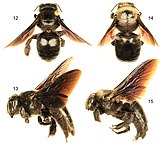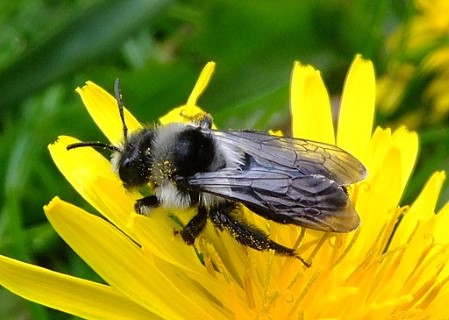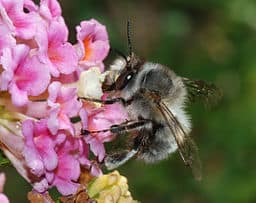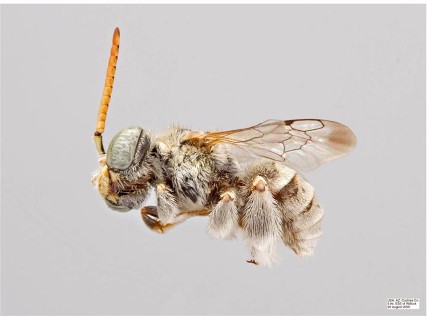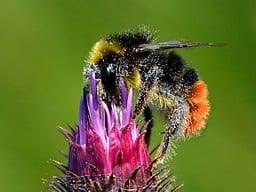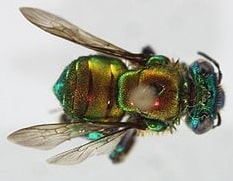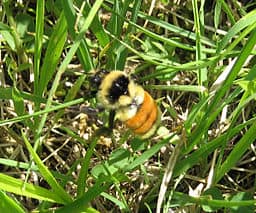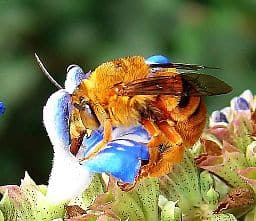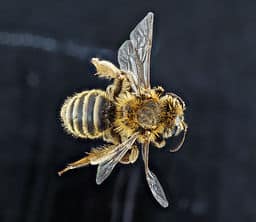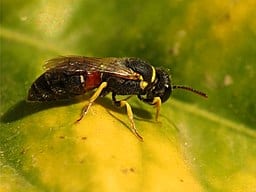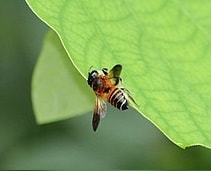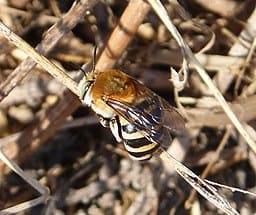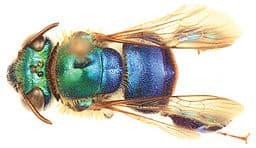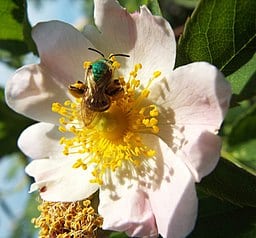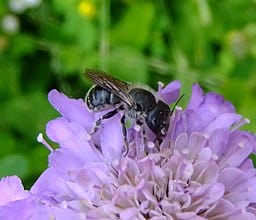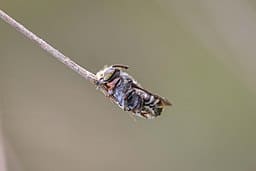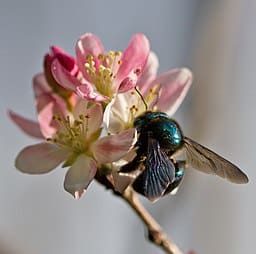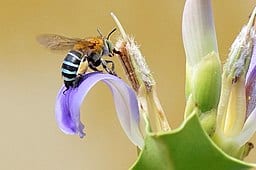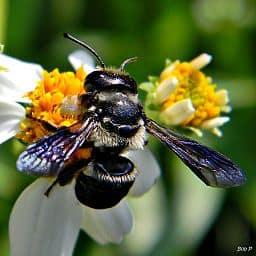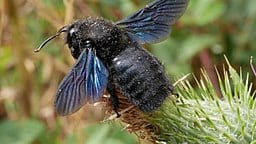There are around 20,000 species of bees known globally. There might even be some species of bees that are yet to be discovered. They come in a various sizes that range from a couple of millimeters up to 2 inches. There are also different colors of bees, although commonly known to be black and yellow, other species can be more vibrant hues of orange. In this article, you will learn about the various colors of bees and species that are specific to these colors.
So, what colors can Bees be? Contrary to popular belief, bees are not limited to black and yellow. In fact, they come in a variety of colors which include; black, white, red, orange, green, blue, and even purple! Ordinarily, we are accustomed to seeing yellow and black striped bees but these are the Hollywood bumble bees; there’s a whole range of colors out there across the species.
Table of Contents
Can Bees be Black?
Yes, there are black bees. The next time you assume that it’s a fly buzzing about your picnic space, think again. Here are two common kinds of black bees:
1: Large Arabian Carpenter Bee (Xylocopa sulcatipes)
Fun Fact: The male carpenter bee does not have a stinger!
There are actually 31 subspecies of Xylocopa bees. They are often large in size and are vibrant in color. However, the Arabian Carpenter bees are characterized by their short black matted hair on both face and thorax. Male bees of this species do not have hair on their face but still have a black exterior.
These bees are either meta social or solitary. When we say metasocial, this means there is more than one generation of the bees in a single nest. Solitary nesting, on the other hand, the bee who builds the nest also does the foraging, laying, and guarding of it’s home.
Male carpenter bees are not equipped with stingers and are not aggressive, making them relatively safe around humans. Whereas, females do have a stinger but are equally non-aggressive as the male. In fact, their stingers are only used when they feel threatened.
2: Ashy Mining Bee (Andrena cineraria)
Fun Fact: The mining bees dig tunnels in the ground which they cover after foraging and returning home. This makes their nest look like a tiny volcano!
The Ashy Mining Bee is more common in Europe and is a subspecies of the Sand Bee. It acquired its name from this distinct color; black with gray hairs. Females of this species are entirely black with gray hair bands across its thorax. Males, on the other hand, are also black, but its thorax is covered with gray hairs.
These bees are very docile and quite safe around humans. They are solitary bees and prefer to nest in gardens, orchards, flowerbeds, and farms. After mating, male bees die and, the females proceed to building their nests. Their nests are simple burrows with dozens of brooding cells. The female bees will then lay one egg in each cell that is filled with a mixture of pollen and nectar.
Can Bees be White?
Yes, there are white bees and no, they’re not albino. White bees are not products of a genetic anomaly, and they do not lack pigment. In fact, white bees are mixed with other colors as well. Here are two examples.
1: White Digger Bee (Habropoda spp)
Fun Fact: Digger bees live alone but build there nest close to other digger bees to form small communities much like our own towns and cities.
Habropoda bees are Native to Central and North America. They are very hairy, and a total of three subspecies are known to be white. These bees are often active through spring, especially during the early part of the season to avoid cold areas. They are solitary bees that are often seen in urbanity.
They are characterized by their white and pale yellow fur that covers their entire body. Some species would have a tricolor effect with black and yellow hairs too. They are quite fuzzy and large, you would mistake them for a regular bumblebee.
These bees are part of the Apoidea superfamily of 5,700 species and there are dozens of identified Habropoda species. This particular species of bee is comfortable in chilly weather that you can catch them buzzing about on early spring.
These bees have quite unusual behavior. They make their nests under the ground. They also seem to cross through winter as adults, having matured over fall. Since they prefer cooler days, you may not be able to spot them during hot summers.
2: White Haired Bee (Anthophorula compactula)
Fun Fact: The color of this bee comes from the dense white hair covering its black body. It is also the most common Bee in Texas. You could say it is the real star in the lone star state and even have long horns!
Generally, bees under geneus Anthrophula cover a variety of bee types that range from honey, orchid, or digger bees. In fact, there are about 60 species described. These species are often hairy like bumble bees with long horns. Their bodies are black, but this is covered with lush hairs that are often pale in color or simply white.
They are mistaken for hornets due to their wasp-like appearance, but are not as aggressive. The hairs on their bodies allow them to gather and spread more pollen during a single trip.
Unlike the more familiar, honeybee, these bees live alone and create nests by using soil or other mud-like materials.
Can Bees be Red?
Yes, there are red bees but they are not as common as you may think. One distinct species with the red hue is the Red-tailed bumblebee and they are not very common in the United States.
Red-Tailed Bee (Bombus lapidarius)
Fun Fact: The red-tail is the most common Bee in Central Europe but, despite the name, the tail hair is actually orange on the female and more yellow on the male.
Also known as the red-tailed bumblebee, these bees are abundant throughout Central Europe and is popular because of its distinctive red body. Female workers and queens of the colony look similar, but the queens would be much larger in size. The males of this species also have a yellow band on the abdomen and face.
These species have a rather simple colony composed of only a few hundred bees in one nest. The nests are often located in open terrain where they have access to large foraging landscapes. They are known for flying thousands of meters away from home, just to forage for food.
The colonies are often initiated by the queen. The worker and male bees keep the colony thriving. Though the queen is treated superior above the rest of the bees within the colony, there is no hierarchy between the working class.
Can Bees be Orange?
Yes, there are orange bees and there are seen in a variety of families including the Euglossini tribe, more commonly known as orchid bees. Here are some of the species that are more commonly seen:
1. Orange Orchid Bee (Euglossa hansoni)
Fun Fact: Although native to South America and the West Indies, these bees been successfully introduced to Florida and are thriving. Their colouring is called chromatic, meaning it can change colours in different light, going from green to Florida orange!
Orchid bees come in a variety of colors which also include orange across the center of their back. They are common in the US and South America. They have over 200 co-species with new ones being discovered every single year, and because of this they are known to be the most diverse species in the world.
They get their name from the peculiar behavior of the males of this species. They collect scents in their hind legs, in order for them to get the right mixture of scents, they need to travel long distances that may cover up to 30 miles per trip. There is no specific reason why these bees collect these scents, but some experts seem to think it is used for attracting mates.
Not all orchid bees make their own nests, in fact, some species prefer to take over other nests that are situated in cavities of wood or bamboo stems. The nests are lined with resin which is collected and placed by the female bees.
2. Orange Belted Bumblebee (Bombus ternarius)
Fun Fact: The buzzing sound from this bee is created by the muscles used for flight and not the wings.
These bees are also classified as Tricolor Bees since it combines an mixture of black, yellow, and orange. It is part of the bumblebee family and is quite hairy. The queen and female workers look similar to each other – black faces with yellow hairs and orange abdominal segment. They only differ in size, the queen is exponentially larger than the rest of the colony. Drones, on the other hand, have yellow heads with black hairs with orange belts.
The queen and worker bees are equipped with a stinger and can repeatedly sting an individual without risking death, however this species is not normally aggressive. It will only attack when provoked.
This particular species practice colony nesting, and ensure that there is a consistent supply of workers to maintain the nest. Worker bees are responsible for most of the chores that includes maintenance of the nest, foraging for food, and tending to the larvae.
3. Teddy Bear Bee (Amegilla bombiformis)
Fun Fact: This is native only to Australia and lives a solitary life, meaning that it lives alone and makes single cell nests with a ball of pollen and nectar left by each single egg.
No you can’t hug this bee, but it is as fuzzy as it sounds. This bee that is native to Australia, is also known as the golden-haired mortar bee. It is rather large and furry that it looks like a bumblebee, but is of a different genus entirely. They are covered in orange-brown fur, and have hairless bands on its abdomen. When exposed to bright light, you can easily identify the bee in an orange hue rather than gold as its name implies.
Their nests deviate from the regular hexagonal brood cells to urn-shaped ones that measure up to 10 centimeters in length. They often nest on the ground near creeks and rubble.
Can Bees be Yellow?
Yes, of course bees can be yellow, in fact most bee species are yellow with black segments. For this article we will focus on bees that are entirely yellow, or have unique yellow features that are not common to your regular bees.
1. Small Mining Bee (Perdita spp)
Fun Fact: This is considered one of the worlds smallest bee, measuring around 0.19 inches in length, around 5 millimetres.
The Perdita species are the smallest member of the Andrenidae family. There are about 253 subspecies under this particular genus. They are native to West America and are more accustomed to warmer conditions. It is known for its miniature size and is often mistaken as termites or ants. They are extremely picky and only forage from a couple of plant species. They are bright yellow with a thin series of bands on its abdomen.
These bees are solitary in nature and prefer to nest on the ground. Females do not line their brooding cells with resin or wax, instead, they used a special secretion from their glands to coat the ball of pollen they collect from the flowers they visit. The larvae then feed on the pollen ball.
2. Yellow-Faced Bee (Hylaeus spp)
Fun Fact: This bee resembles a wasp and actually gathers pollen in his neck, called the crop, instead of outside of the body due to a lack of body hair for it to stick to.
These bees are quite similar to wasps that it’s wasp-like structures often make them threatening. They have yellow faces and yellow streaked bodies. They are often seen in the tropics like Hawaii, and there are three known subspecies; Hylaeus kuakea, Hylaeus longiceps, and Hylaeus mana. What is unfortunate is that this particular species of bees are included in the endangered list.
They are quite important to the Hawaiian community since they are the major pollinators of the region, but due to the fact that they are face extinction, locals have been trying to find ways to preserve their species. In order to gain protection of the species, they have petitioned the US Fish and Wildlife Service to protect these species back in 2009.
These bees, like the Perdita species, are also picky with the vegetation they consume, which is the main reason for their low population. They are also quite small and are prone to predation and habitat loss.
3. Leafcutter Bees (Anthidium spp)
Fun Fact: The leaf-cutter gets its name from the half-moon shaped holes it leaves in a leaf. These section of leaf are used to build their nests like sections of a wall.
Almost all leafcutter bees are yellow with black stripes. They are smaller than a honey bee but are quite as productive in spite of not having a hive. They are known to be the most productive pollinators. The females carry pollen on the hair on their bodies and then scrapes the pollen off upon reaching the nesting hole. During the transition, the pollen also fall off and land on other plants.
They are known to be gentle by nature since the female of the species does all the chores. She does not have time to defend the nesting hole as well. So, even though they have stingers, they will only use it when threatened – which is not really that often.
Unlike honeybees, these bees live in stem holes and cover their egg chambers with leaf pieces. This is where their name originated from. The leaves are meant to protect their eggs from possible predators.
4. Digger Bee (Centris spp)
Fun Fact: Digger bee females hold all the power and are in charge all building nests for themselves and their young. The males are therefore very territorial and will fight for their chosen females, often guarding closed underground nests.
This particular bee is covered in yellow fur and have reddish legs. Their wings are fairly transparent and their eyes are quite green. They get their common name from their peculiar habit of digging through the ground. They are very used to elevated temperatures that they are more common in places that are hot and dry.
These bees are solitary in nature and this allows a dual mating strategy. After mating, the female bee will find a place for her nest and dig diagonally. They will then create a chamber that measures an inch in length, similar to a pot. It is then lined with wax. Female bees creates hundreds of burrows in her lifetime.
Can Bees be Green?
Yes, there are green bees and they are often metallic in form that make them seem like jewels of nature. It is quite rare to see these kinds of bees but there are quite a few of them around, most of the time they are mistaken to be large flies due to its strange color.
1. Green Orchid Bee (Euglossa cyanura)
Fun Fact: The orchid bee is so named because it is attracted to the distinct fragrance of the orchid flower and actively collects this fragrance to impress female orchid bees. Its nature’s bee perfume!
Similar to its orange counterpart, the Green Orchid Bee are common in the US, South America, and even Africa. They prefer warm climates which is why you might find them more common in states like Florida. Their green color is often in a metallic sheen which is rarely seen in bee species.
Most of these species are solitary, but there are a few that are communal. Females of the species do most of the foraging. They gather pollen and nectar as food from a variety of plants. They also collect mud and other similar material to use for their nest. The male species, as mentioned earlier collect scents with their modified hind legs.
2. Metallic Green Sweat Bee (Agapostemon spp)
Fun Fact: Sweat bees are literally attracted to the sweat of mammals and feed on the salts that occur naturally in sweat.
This species is common in the western hemisphere and are quite popular because of their metallic green tinge. Their names come from the fact that they are quite attracted to human sweat and they utilize the salt from the sweat as a form of nutrition. Males often have yellow-striped abdomen with a green thorax, while the females would entirely be green.
They often nest on the ground in dense aggregations. There are some subspecies that are communal, this means there is no reproductive division of labor like how social bees have their colonies. Many female bees share the same nest which is located beneath the common entrance space of the main nest itself. They each make their own brooding cell for their eggs. In turn, they collect their own pollen and nectar to place in the cells.
Can Bees be Blue?
Yes, bees can be blue and there is a large list of common blue bees worldwide. Here are a few of our top five picks.
1. Blue Orchard Mason Bee (Osmia lignaria)
Fun Fact: Mason bees are the favourite pollinator for farmers as they are very docile and although they have a stinger, actually use it for depositing their eggs.
The Orchard Mason Bee is part of around 4,000 native bee subspecies in North America. They have a metallic blue color and is often confused with large flies. They are also known for their unique hue and unusual nesting habits. They create cells for their broods on reeds using mud dividers.
After hatching from their cocoons, the first task of the female would be to find a mate. The female mates only once and waits for her ovaries to fully mature. During this time, she will be feeding. By the time her ovaries are fully mature, she then seeks a suitable nest. This is often in holes or tubes.
These bees are very shy in nature and only sting when they are threatened or are in eminent danger. They do not attack to defend themselves, instead they use their stinger as an egg guide. It is because of their docile characteristic, that mason bees are preferred by farmers for pollination.
2. Cuckoo Bee (Thyreus nitidulus)
Fun Fact: Cuckoo bees are just like the birds of the same name and will replace another bees eggs with their own so they can move on without having to care for their young themselves.
Like all bees, the Cuckoo Bee is covered with fur and flattened hair. This fur is responsible for bringing out the blue and black patterns on its body. The face and legs of these bees are covered with pale blue hair. It’s wings are transparent with a tinge of brown and purple. They are also quite stocky and sturdy.
They are native to Australia and have been accustomed to the country’s warm climate. The species have adapted to a parasitic lifestyle to survive. When the female bee has eggs to lay, she will seek out nests of equally vibrant bee species such as the blue banded bees. This way, the host bee will end up caring for her eggs. By the time the eggs hatch, the host larvae would not have enough to eat since the parasite larvae has already consumed all the pollen balls.
3. Blue Carpenter Bee (Xylocopa caerulea)
Fun Fact: The females have a stinger but the males do not. The females are also very picky with their nest sites will share a nest rather than choose a sub-standard nest site of their own.
Similar to its Arabian cousin, the Blue Carpenter Bee is quite furry and large averaging almost an inch in length. They are covered with an array of thick light blue hair that gives it a striking blue color. A finer coat of blue hair covers it’s abdominal segments and legs as well. They are widely seen in Asia especially in Southern China and have recently been spotted in some regions of India.
Almost all of the bees in this species are females. The females have a brilliant blue hue and are equipped with a stinger. Males, however, have a greenish brown tinge and have no stingers at all.
These bees are solitary bees and are constantly searching for a perfect spot to nest. If by the time a queen bee is not able to find a perfect nest by the time she is about to lay her eggs, she will share a common entry hole with another bee being somewhat semi-solitary.
4. Blue Banded Bee (Amegilla cingulata)
Fun Fact: This bee does not end with just the blue on its body. The blue banded bee is attracted to all things blue, particularly lavender plants and blue clothing.
There are about 250 subspecies of Amegilla in the world, but these particular bees are known for the blue bands on their abdomens. These pale blue stripes on its abdomen is quite vibrant and make them look similar to the Cuckoo Bee. The male bees can be identified with the number of bands on their abdomen, they have five while the females have four.
These bees are quite beneficial to the Australian agriculture scene. They contribute at least 30% of the crop production in the nation. Although native to Australia, they have been seen in Papua New Guinea, Malaysia, and India.
They are not as aggressive as other bees but they are quite quick. They are solitary bees that prefer to nest on stems and burrow in the soil.
5. Blue Leafcutter (Hoplitis fulgida)
Fun Fact: These are a larger bee, measuring 0.47-0.71 inch or 12-18 millimetres. These bees are actually quoted as saving the failing Alfalfa seed industry in the 1940s.
Similar to our previously mentions leafcutter bees, these species protect their brood by cutting leaves and stuffing them down the tubes they lay their eggs in. What makes this particular subspecies different is the blue hue of its body that is often metallic. They are moderately sized and quite stocky. The females of the specie are equipped with hairs under their abdomen called the scopa that is used to collect pollen. This makes their abdomens appear golden.
Leafcutting bees are also equipped with mandibles that allow them to cut leaves. They create tube like nests that contains several cells. Each of these cells would contain a loaf of pollen and one egg. During the time the egg is being incubated in the cell, the bees cut leaves to cover the holes to protect their eggs from predators.
These bees are common in North America and are quite important in the pollination process. Due to the recent drop in population, local farmers have made it a point to take an extra step into improving their living conditions and promote their population growth.
Can Bees be Purple?
Yes, bees can be purple too. It looks like we covered the basic colors of the rainbow already, and here is the final bee in our list.
Purple Carpenter Bee (Xylocopa violacea)
Fun Fact: This purple wonder has a bright violet color and is now the largest bee found in the United Kingdom and since they are not fussy foragers they are becoming more common in large city environments like London.
At first glance, you might think that this bee is actually black. But once you see them under bright light that’s when you will notice it’s purple sheen. They are part of the large sized bees that range to almost a full inch in size.
Their name comes from their ability to drill through dead wood with their mandibles. They create tunnels and use these to lay their eggs in. Each tunnel can hold up to 15 eggs at a time, and each egg will have a pollen ball ready for them as soon as they hatch.
They are not very particular on the plants they forage on, which make them quite adaptable to pretty much any season. They do prefer warmer climates, which is why you might find them sunbathing on the trunks of trees during the day.
In spite of females having stingers, these bees are not aggressive and their mission in life is solely to collect nectar and pollen from flowers. Males are not equipped with stingers, like much of the other species of bees but they are quite aggressive towards other males that may be hovering around the females they choose to mate with.
Conclusion
Like all of mother nature’s creations, bees are quite remarkable. It’s amazing to know that they come in a variety of sizes and colors that also attribute to different attitudes and nesting patterns. The next time you hear something buzzing about, don’t be too scared to take a second look. It may be your chance to see a rare bee.

